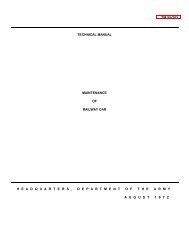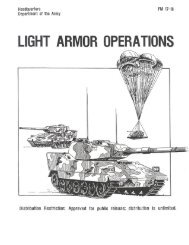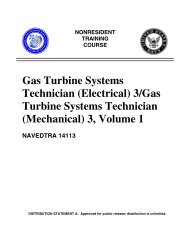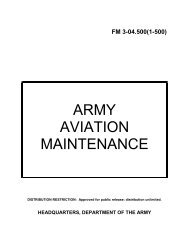AIR DEFENSE ARTILLERY REFERENCE HANDBOOK
AIR DEFENSE ARTILLERY REFERENCE HANDBOOK
AIR DEFENSE ARTILLERY REFERENCE HANDBOOK
You also want an ePaper? Increase the reach of your titles
YUMPU automatically turns print PDFs into web optimized ePapers that Google loves.
FM 44-100-2<br />
4-55. Mobile Subscriber Equipment. THAAD includes communications<br />
equipment that supports an interface into the Army’s MSE area common<br />
user system (ACUS) network. This equipment functions as a MSE small<br />
extension node (SEN); however, unlike other ADA systems this functionality<br />
is integrated into the LCS design. Current LCS equipment associated with<br />
MSE are: two each AN/GRC-226 radios, encryption devices, compact digital<br />
switch (CDS), and the availability to have THAAD non-organic MSE and<br />
ACUS communications system connectivity.<br />
4-56. SINCGARS Radios. SINCGARS is a VHF single channel, push-to-talk<br />
radio which operates either in single frequency or frequency hopping modes<br />
at 30 to 88 MHz. The THAAD battery uses several models of SINCGARS. In<br />
UOES only, all primary convoy vehicles contain an AN/VRC-87A SINCGARS.<br />
The LCS, launcher, and launcher prime mover contain the AN/VRC-90. The<br />
LCS radio voice interface is connected to the radio connector panel to provide<br />
access for voice circuits. These radios provide the secondary voice<br />
communication and support voice on the move for other THAAD elements.<br />
Within the battery there are additional SINCGARS radios which are used to<br />
support the functions of command, logistics, administration, intelligence, and<br />
operations. All SINCGARS contain internal COMSEC capability, mounted<br />
(AS-3900) and dismounted antennas (OE-254).<br />
4-57. THAAD Non-Organic MSR and ACUS Connectivity. At the<br />
communication demarcation panel, there are two (2) types of signal<br />
connectors. There are three (3) CX-11230 digital trunk group connectors.<br />
These connectors allow THAAD to have curbside signal support. The next<br />
types of connectors are binding posts used to extend and connect DNVTs,<br />
DSVTs, or individual data circuits to a local subscriber. The wire may be WD-<br />
1 or WF-16.<br />
4-58. Wire. Wire communications consist of wires connected to field<br />
telephones, terminal boxes and switchboards. The wire is either WD-1 or WF-<br />
16, which as previously stated, is used to extend the subscriber terminals to<br />
the required location.<br />
Internal Communications Networks<br />
4-59. Battery Mission Operations Network. The battery mission<br />
operations network provides FO and EO command and control. The internal<br />
battery network connects force operations and engagement operations TSGs,<br />
the radar, and launchers in a variety of configurations using radio and FOC.<br />
The EO/FO TSGs are connected to the radar and launchers using fiber optic<br />
cable when collocated, or radio to a remote launcher or radar with the use of<br />
a CR or SSI, respectively. The FOC system interconnects with the THAAD<br />
voice communication subsystem station in the TOS. The battery TOC<br />
includes two TOS shelters, one for FO and one for EO, and two LCS shelters<br />
that functionally support force operations and engagement operations.<br />
Internal communications for each section supports force and engagement<br />
operations when emplaced (figure 4-10, page 4-16).<br />
4-60. Battery Wire/Telephone Network. The battery wire network is the<br />
primary means of voice communications among the battery elements<br />
4-15











